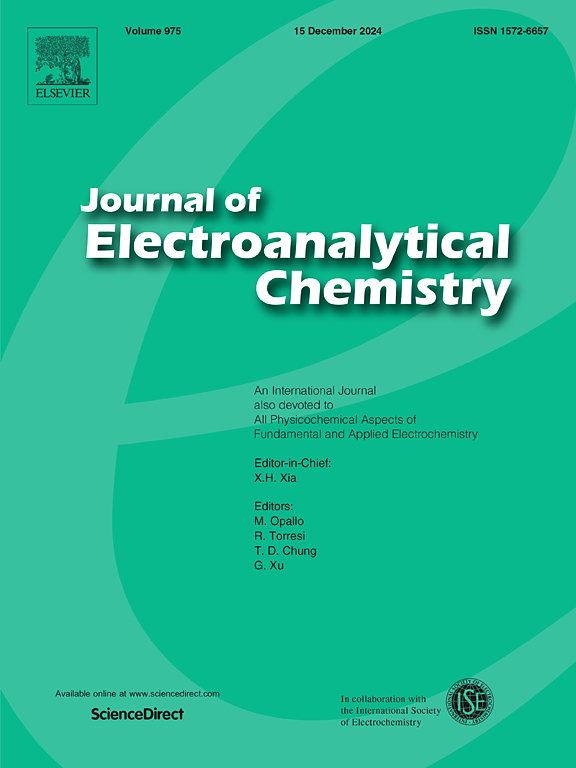非对称超级电容器用SrSnO3/rGO/PANI三元纳米杂化材料及其电化学性能
IF 4.1
3区 化学
Q1 CHEMISTRY, ANALYTICAL
引用次数: 0
摘要
新材料的发展为改善材料的特性为其超级电容器的应用打开了大门。本研究采用简单的聚合方法合成了一种新的SrSnO3/rGO/PANI纳米杂化物。通过XRD、Raman、XPS、fg - sem、TEM和BET等光谱技术对合成的SrSnO3/rGO/PANI纳米杂化物进行了验证。为了评估生成的样品的电化学性能,使用了几种电化学方法,如电化学阻抗谱(EIS)、恒流充放电(GCD)和循环伏安法(CV)。制备的SrSnO3/rGO/PANI纳米复合材料(NC)在三电极测试中,在电流密度为1 a /g时,比电容(Cs)达到1003.26 F/g,比容量(Csp)达到239.67 mAh/g,具有显著的储能特性。此外,SrSnO3/rGO/PANI/ AC ASC器件在1 A/g电流密度下的双电极测量显示Cs为237.67 F/g。此外,复合材料表现出优异的循环稳定性,保持了81.41%的初始电容,即使在10,000次循环后也保持了90.73%的库仑保持率。最终,该ASC器件在1 a /g时的功率密度为895.02 W/kg,能量密度为106.95 Wh/kg。结果表明,SrSnO3/rGO/PANI NC是一种有效的电极材料,可用于储能应用。本文章由计算机程序翻译,如有差异,请以英文原文为准。

SrSnO3/rGO/PANI ternary nanohybrid for asymmetric supercapacitor and its electrochemical performance
New material development opens the door for improving the characteristics of materials for their supercapacitor applications. This study uses a simple polymerization approach to synthesize a new SrSnO3/rGO/PANI nanohybrid. The synthesized novel SrSnO3/rGO/PANI nanohybrid was validated by spectroscopic techniques such as XRD, Raman, XPS, FEG–SEM, TEM, and BET measurements. To assess the electrochemical properties of the generated samples, several electrochemical methods are used, such as Electrochemical Impedance Spectroscopy (EIS), Galvanostatic Charge–Discharge (GCD), and Cyclic Voltammetry (CV). The resultant SrSnO3/rGO/PANI Nanocomposite (NC) demonstrates remarkable energy storage characteristics with an enhanced specific capacitance (Cs) of 1003.26 F/g and specific capacity (Csp) value of 239.67 mAh/g at a current density of 1 A/g on three–electrode testing. Additionally, SrSnO3/rGO/PANI//AC ASC device demonstrated Cs of 237.67 F/g at 1 A/g current density using two–electrode measurements. Moreover, the composite exhibits exceptional cyclic stability, holding onto 81.41 % of its initial capacitance, and showed 90.73 % coulombic retention even after 10,000 cycles. In the end, the ASC device delivered a high power density of 895.02 W/kg at 1 A/g and a high energy density of 106.95 Wh/kg. According to the results, SrSnO3/rGO/PANI NC serves as an effective electrode material for applications involving energy storage.
求助全文
通过发布文献求助,成功后即可免费获取论文全文。
去求助
来源期刊
CiteScore
7.80
自引率
6.70%
发文量
912
审稿时长
2.4 months
期刊介绍:
The Journal of Electroanalytical Chemistry is the foremost international journal devoted to the interdisciplinary subject of electrochemistry in all its aspects, theoretical as well as applied.
Electrochemistry is a wide ranging area that is in a state of continuous evolution. Rather than compiling a long list of topics covered by the Journal, the editors would like to draw particular attention to the key issues of novelty, topicality and quality. Papers should present new and interesting electrochemical science in a way that is accessible to the reader. The presentation and discussion should be at a level that is consistent with the international status of the Journal. Reports describing the application of well-established techniques to problems that are essentially technical will not be accepted. Similarly, papers that report observations but fail to provide adequate interpretation will be rejected by the Editors. Papers dealing with technical electrochemistry should be submitted to other specialist journals unless the authors can show that their work provides substantially new insights into electrochemical processes.

 求助内容:
求助内容: 应助结果提醒方式:
应助结果提醒方式:


